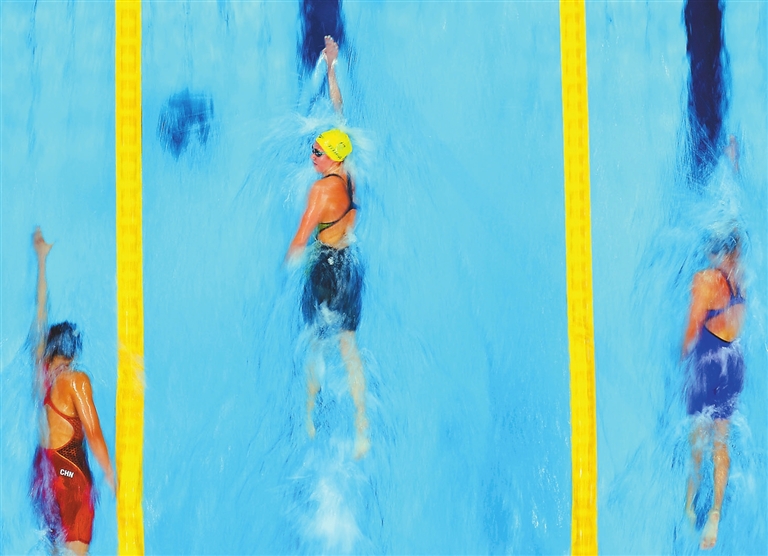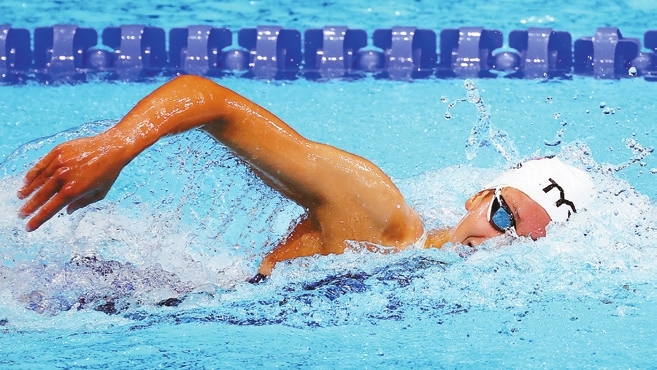

IF you’re looking to freshen up your workout routine, and even push it to the next level, try swapping your weights and treadmill for the pool. Swimming is an effective way to build and tone your muscles while improving endurance. It blends a frequent cardiovascular workout with simultaneous strength training due to the resistance of the water, according to Philip Abundo, a private swimming instructor in Perth Amboy, New Jersey, the United States. “When it comes to swimming, if you want to go and see how important a workout like the squat is, swimmers squat in every single stroke,” Abundo said. “You are striking the water with the upper body at a constant rate and you are kicking the water at a constant rate at full speed and force.” Swimming targets the same muscles that you might work out in the weight room. But rather than dividing your workouts into separate sets for upper body, lower body, core and cardio, swimming allows you to simultaneously get a full-body workout in a single continuous motion. Here’s a look at which swimming strokes target each respective muscle groups. Butterfly: chest, back, core and shoulders The butterfly stroke is swum on the chest with both arms moving symmetrically. The arms start off extended above the head and then move backwards in with the palms pushing through the water. The arm motions work out the shoulder muscles known as anterior deltoids, and chest muscles known as pectorals. “Your arms should be kept straight throughout the entire motion of the entire stroke. You’re doing basically the equivalent of a tricep extension, and you’re just overreaching, bringing it back behind you, towards your legs, and then making a perfect circle with both arms ending up at the same time,” Abundo said. The arm motions are combined with the dolphin kick, which is when both legs are pressed together and kick up and down like the motion of a dolphin’s tail. The motion is comparable to a hanging knee raise, which helps build lower core muscles. Backstroke: back muscles and thighs The backstroke is swum on the back with each arm moving backward one at a time in a paddling motion. These motions work the latissimus dorsi - muscles located on the shoulder. The arm motions are then combined with a flutter kick, which is when each leg makes a light push one at a time. The resistance of the water works the hamstrings. “A lot of swimmers, me included, would argue that a lap of backstroke feels the worst compared to the other strokes, just because your legs are really working from that angle,” Abundo said. “Your legs are really working from that angle, because if you swim on your back you’re using your hamstring muscles.” Freestyle: cardio, endurance and weight loss All swimming strokes are an effective cardio workout, but freestyle is a unique cardio challenge due to its unique breathing patterns. As a high-intensity cardio workout, the stroke comes with benefits that include weight loss, improved health and stress reduction. Freestyle is swum on the chest and requires the head to regularly submerge and re-emerge. The arms alternate to make windmill arc motions while the head is underwater, and the swimmer breathes at their side. It is accompanied by flutter kick. “The sprint swimmer who swims the 50 meters or 100 meters is probably only going to breath 3-5 times throughout the entire race,” Abundo said. “We’re training freestyle swimmers for short distances to breathe as little as possible because every single time you breathe, it counts as a second.” “When it comes to freestyle at long distances you are swimming at a certain pace and your breathing has to follow a certain rhythm,” he added. (SD-Agencies) How to get started You will need to locate a pool near you. Many gyms and community centers offer lap swimming times. It is a good idea to check out a few facilities in your area to determine which one works for your budget and lifestyle. Swimming takes a little coordination. If you are totally new to swimming it may be beneficial to look into swimming lessons. You will learn the different strokes and breathing techniques to help you get the most from your workout. A good goal for beginners is to learn how to swim freestyle. When you are just getting started, it is important to focus on your stroke, breathing, and kicking technique – not how far or how fast you are swimming. Gear Just like any other physical activity, you will need to have the appropriate gear to participate. Start with goggles, a swimsuit and a swim cap. Optional: Kickboard and a pull-buoy (most facilities will have these on hand); Waterproof watch (helpful for timing interval workouts). Ease into a regular routine Consistency is the key to learning anything. Start with 10 swim sessions of easy, steady swimming over a three-week period. After those first three weeks, you should feel your body begin to adapt to the activity. In each of these sessions, swim for as long as you can, resting as much as you need. Aim for at least 20-minute sessions. Don’t get discouraged if you get winded quickly; your body is adapting to a new activity. Once you have a handle on the basics, try swimming laps for 20 to 40 minutes at a pace that keeps your heart rate elevated. Remember to drink plenty of water and take breaks. Lane etiquette Familiarize yourself with the facility’s rules for sharing lap lanes. When three or more swimmers are sharing a lane, typically facilities will ask you to do “circle-swimming.” When you are circle-swimming, you go up on one side of the lane and return on the other. | 
